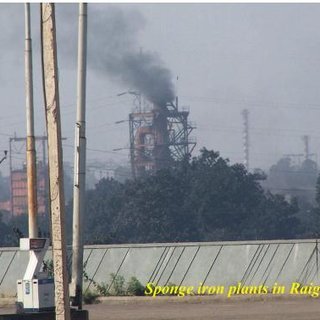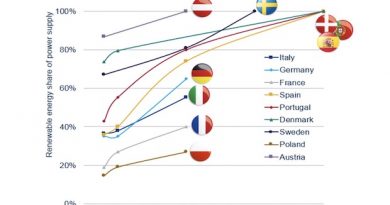Examining the Biggest Polluters: Report Card of Steel Industry

An increase in steel production is only natural to meet the growing demand of human civilization – building and expanding cities and infrastructure, manufacturing cars, aeroplanes, ships, and many household items. The world’s steel demand is projected to increase from 1,880 Mt (million tonnes) in 2020 to up to 2,500 Mt in 2050. But, with the increase in demand for this crucial substance, there comes a problem. The steel industry is also one of the biggest polluters in the world. Our report card of the steel industry details the standing of the steel sector in the world’s pollution-bound scenario.
The steel sector is highly reliant on coal, which meets 75% of its energy demand, as per one IEA report. Further, the energy intensity of crude steel must decline by 0.2% annually during 2020‑2030 to attain Net Zero Emissions by 2050. Yet energy efficiency on its own cannot decarbonise the sector by mid-century. Hence, there is an apparent need for transformational change. The breakthrough in novel technologies for the sector needs to be by as early as 2030.
Share in Global Pollution
As per the latest estimates, the carbon-intensive steel industry accounts for approximately 7% of global carbon dioxide (CO2) emissions, one of the biggest polluters. Thanks to the metallurgic methods of production and plethora of uses of steel in various forms, even the most modern steel-manufacturing techniques release substantial amounts of greenhouse gases and other air pollutants.
The steel industry currently emits approximately 2.6 Giga Tonnes (GT) of direct CO2 emissions per year and 1.1 GT of indirect CO2 emissions from the power sector and combustion of steel off-gasses.
China is the biggest producer of steel (1,032,800 tons in 2021), with approximately 10 times the steel manufacturing capacity of Japan. India (118,100 tons), surpassing Japan is the second biggest manufacturer of steel. Japan (96,300 tons) and the US (86,000 tons) are other major steel manufacturing nations.
Measures Taken to Reduce Carbon Footprint
The CO2 intensity of crude steel production remained constant in recent years. As per IEA, to achieve Net Zero Emissions by 2050, the energy intensity of crude steel needs to decline by 0.2% annually during 2020‑2030. Apart from improvements in energy efficiencies, innovations in the upcoming decades will be crucial for commercializing low emissions processes. The role of the government in providing R&D funding, creating a market for near-zero-emissions steel, relevant policies, expanding international cooperation, and developing supporting infrastructure will drive the change in steel industry.
As many countries are keen on achieving carbon neutrality by 2050 or other such target years, steel producers are also setting targets to achieve emissions reductions. The past two or three years have been very significant in terms of the evolution of efforts and measures by the stakeholders.
Private Measures
Companies and various institutions accounting for roughly one-third of global steel production have already set targets to achieve net zero emissions by 2050 or earlier. Many regional industrial bodies – such as Eurofer (the European steel association), the Japan Iron and Steel Federation, and The Energy and Resources Institute in India – have also prepared roadmaps for reducing emissions.
For instance, the European steel industry aims to cut carbon emissions by 55% by 2030 compared to 1990 levels (equivalent to over -30% compared to 2018 levels) and to achieve climate neutrality by 2050.
The measures are also taken by the leading steel manufacturers (also some of the biggest polluters) across the globe, encouraging other corporates to develop their targets to achieve emissions reductions in their steel production. All of the world’s largest steel firms – China Baowu Group (China), Arcelor Mittal (Europe), HBIS Group (China), Nippon Steel Corporation (Japan), and POSCO (South Korea) – have set their net-zero target year as 2050.
Manufacturers in Biggest Steel Producing Countries
China’s Baowu Group is the largest steel firm in the world with 115MTPA production in 2020. It has goals of reducing carbon emissions by 30 per cent to 1.3 tons by 2035, and achieving net-zero by 2050. Baowu has been working on hydrogen-rich blast furnace technology and pure hydrogen furnace technology. Apart from renewable projects and investments in technologies, the firm has established a carbon neutralization fund. It is a green low-carbon metallurgy innovation fund that will spend 35 million yuan ($5.5 million) each year to research low-carbon metallurgy. HBIS, another Chinese firm and one of the biggest steel manufacturers of the world, has also set target of carbon-neutrality by 2050. HBIS has invested over RMB¥20.3billion covering 430 energy conservation and environmental protection projects.
Tata Steel Ltd. is the firm in India with the largest steel producing firm boasting a capacity of 34 MTPA. Tata Steel has a mission to bring down the carbon dioxide emissions to 1.8 tonnes of CO2 per tonne of crude steel by 2030. In addition, the firm aims to go water-neutral by 2030 and a zero-effluent organisation by 2025. Further, the firm aims to produce a major portion of its steel from scrap-based production processes in the coming decade, while the hydrogen-based sustainable steel production is also a part of its strategy. JSW Steel, with an 18 MTPA production capacity, is also looking towards goal of achieving carbon neutrality. Apart from tie-ups with various states for 5GW Hydro-pumped storage projects, JSW also secured PPA for 2.5GW renewable projects and commenced operations at a 225MW solar power plant in Vijayanagar, Karnataka. The company has in pipeline 1.26 GW of Wind projects to start operation by FY23.
Japanese steel major Nippon Steel has also set 2050 as a target year to achieve carbon neutrality. The firm aims to build 100 per cent hydrogen-based plants; it wants to boost the use of hydrogen in existing furnaces. In addition, it also plans to make more metal via electric arc furnaces to melt the steel scrap. In JISF’s “Basic Policy of the Japan steel industry on 2050 Carbon Neutrality aimed by the Japanese government”, it declared that the Japanese iron and steel industry will boldly take on the challenge of realizing zero-carbon steel.
Government Measures
There are many policies already in place. Some key policies that target steel industry in general are the EU emissions trading system and India’s PAT scheme for improving energy efficiency.
China also pledged to achieve carbon neutrality by 2060, which would require reducing emissions from its steel plants which are responsible for a third of its total CO2 pollution. In India, the Ministry of Steel has directed the stakeholders to develop a time-bound action plan to reduce carbon emissions in the steel industry. The country has established a Steel Scrap Recycling Policy to increase steel recycling and a Promotion of R&D.
Sweden has developed a roadmap for the steel industry as part of its Fossil Free Sweden initiative. In 2019, the UK announced plans to set up a GBP 250 million (USD 320 million) Clean Steel Fund for new lower emissions technologies. Further, the EU Green Deal aims to develop technology for zero-emissions steel by 2030.




